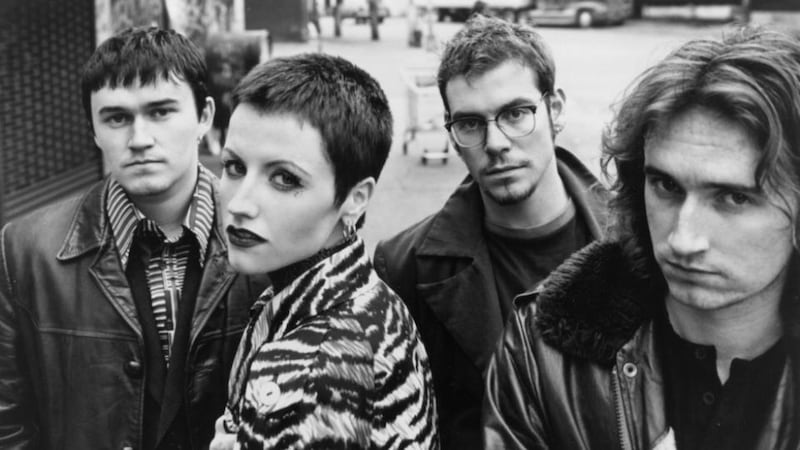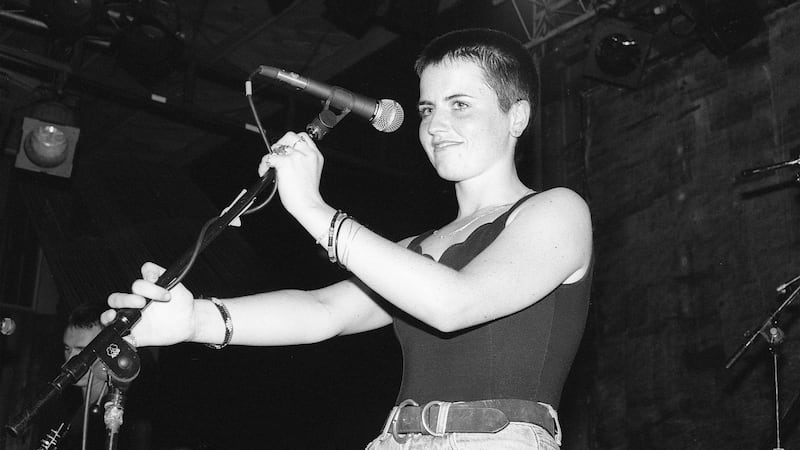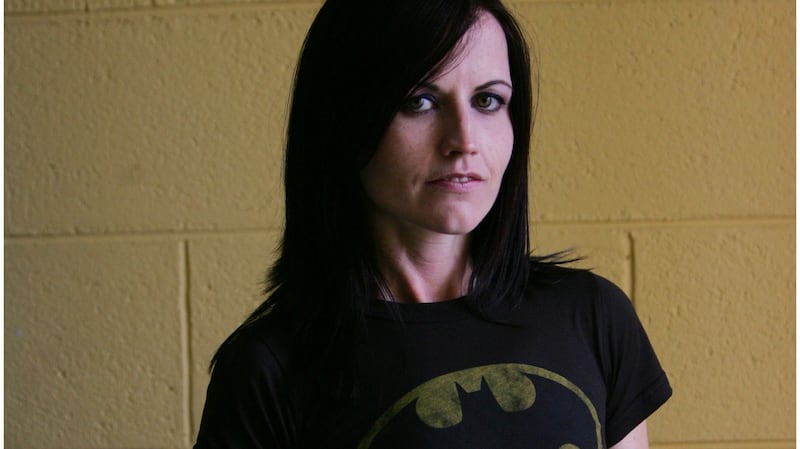The reviews weren’t wild. “Backwoods oiks from Limerick, West Ireland suffused with too much innocence for their own good,” said the NME. The Los Angeles Times highlighted “the Celtic-flavoured folk tinged with gospel sensibilities” but then awarded a backhanded three stars out of five. With write-ups like that, there seemed every possibility The Cranberries’ debut album, Everybody Else Is Doing It, So Why Can’t We?, would be forgotten almost as soon as it was out in the world.
Thirty years later, as the record marks its anniversary on March 1st, the consensus is altogether different. Despite the NME’s jeers, the LP has gone on to sell more than six million copies and stands tall as the ultimate underdog story in Irish rock. It also gave music in this country one of its most iconic figures in the late Dolores O’Riordan, just 19 when the Cranberries became overnight stars.
In March 1993, however, all of that would have felt like a pipe dream. True, The Cranberries had big label backing in Island Records. However, with Britpop on the horizon, the all-powerful British music press wasn’t interested in the specifically Irish strain of angst that fuelled The Cranberries (early on, someone described O’Riordan’s vocals as “the voice of a saint trapped in a glass harp”). There was also the small matter of a Dublin ensemble in whose shadow every new Irish group were destined to shrivel.
At the time, it was just another song and another day, but years later I realise how much that day changed our lives
— Noel Hogan on Linger
“If you thought Irish rock music, you thought U2, but that was way out of our reach,” Cranberries guitarist Noel Hogan would later tell the UMusic website. “Coming from a small town in the south of Ireland, we thought no further than forming a band and playing a local club in front of a few friends if ever we got good enough. Really, we would have been content with that.”
RM Block
That “small town” was of course Limerick City, from which three of the four hailed. The fourth, O’Riordan, was from Ballybricken, a townland 18 kilometres away.
Dolores, the youngest of nine, was shy. Still, she sang as if her soul was caught up in a firestorm. She’d blown her future bandmates away in an audition after their original singer Niall Quinn left to spend more time with his other project, The Hitchers. And though retiring, O’Riordan had an inner steeliness. Standing before Hogan, his bassist brother Mike and drummer Fergal Lawler, she realised they needed her as much as she needed them.
“I really liked what I heard,” she mused. “I thought they were very nice and tight. It was a lovely potential band but they needed a singer – and direction.”
She passed the audition. Determined to kick things up a gear, Noel Hogan pressed into her hands a cassette containing rough sketches of new music. She took the instrumentals away and four days later came back with what would become their second single, Linger. “At the time, it was just another song and another day, but years later I realise how much that day changed our lives,” Hogan said.

Things happened fast for The Cranberries. Geoff Travis, who had discovered The Smiths, became their manager. Another Smiths collaborator, producer Stephen Street, would work with them on Everybody Else Is Doing It, recorded at Windmill Lane in Dublin and Surrey Sound in the UK. They also had the best A & guy in the business, a wily veteran named Denny Cordell who had produced Procul Harum’s A White Shade of Pale and Joe Cocker’s version of With A Little Help From My Friends.
[ The Cranberries: how we made LingerOpens in new window ]
Still, not everything was in their favour. The Cranberries were Irish before it was cool to be Irish (what historians called the “Father Ted dateline”). Meanwhile, the UK music press was too busy dribbling all over home-grown newcomers such as Suede to give them the time of day.
They had not quite meshed as a band either. O’Riordan was an outsider who preferred to sing alone. This resulted in an unusual dynamic during the recording of Everybody Else. The boys would toil all day in the studio. Then Stephen Street would set up for their singer, who’d arrive as they were exiting.
“We’d pass each other in the corridor,” bassist Mike Hogan recollected. “Dolores would say: ‘You know that thing you recorded?’ I’d say: ‘You mean the thing that took me five hours to get right?’ She’d say: ‘Yeah. It’s not working!’”
Behind her introversion, O’Riordan had demons. She didn’t get into these on that first record, which is dominated by lyrics about young love and loss. Only later, on songs such as Fee Fi Fo from 1999′s Bury The Hatchet, would she delve into the sexual abuse she suffered at the hands of a family friend between the ages of eight and 12.
Everybody Else Is Doing It, So Why Can’t We? was a slow burn. In the UK it failed to breach the top five in the month of its release – even as another Irish outfit, The Hothouse Flowers, reached number two on March 20th with their LP Songs from the Rain.

“We were dead in the water,” Noel Hogan told me when I interviewed him for the Irish Examiner several years ago. “When our first album came out we had press officers in the UK playing us bands like Slowdive, saying ‘this is in’. And I was like, ‘you can’t hear the vocals’. It had bombed and we were waiting to be dropped.”
As they cooled their heels, they went on a tour of the Continent with the aforementioned Hothouse Flowers. Raggle taggle folk-pop was squeezed up against plaintive jangle rock. The Flowers had an audience – but not one interested in The Cranberries. Night after night, they played in empty rooms.
“We were about a month into the European tour and we get a call out of the blue, requesting we come to the States,” Hogan explained to UMusic. “Denny Cordell had been working on [the album’s] first single, Linger, in New York and it had become a hit on college radio, where it had gone to number eight. Suddenly, from thinking we were about to get dropped by Island, we went to play our first American gig in Denver, Colorado, opening for The The. We went onstage and everyone knew the songs and the place just went mental.”
Dolores had such a lust for life and for meeting new people. She was never ‘starry’ – if people came up to her and said they liked the show, she’d sit down and gab away for hours
— Suede's Matt Osman on Dolores O'Riordan
America was ready for them and they were ready for America. Coming from Limerick they are always outsiders anyway. Why not be outsiders on the biggest stage of all?
“It was difficult for us first to break into the Dublin scene which was a good thing,” O’Riordan told Ian Dempsey in December 1993, by which time Everybody Else Is Doing It was selling 80,000 units a week in the US. “People tend to break into the Dublin scene and stay there forever.”
“Everything changed because of America,” Hogan told me. That autumn, the group set out on a US tour as support to Suede, floppy-haired wunderkinds beloved of the London music scene. However, what worked in Camden didn’t necessarily come off in Colorado. Out there in the American heartland, it was O’Riordan’s fragility that people took to rather than Suede singer Brett Anderson’s performative androgyny.

Suede nonetheless had warm memories of their time, as their bassist Matt Osman explained to me when I spoke to him for Hot Press.
“That tour gets reported quite weirdly because they blew up while we were there,” he said. “They [The Cranberries] were so much fun. We were much less worldly than we probably made out. They were certainly not very worldly. It was kind of an adventure. We spent a lot of the time just drinking after the shows.
“Dolores had such a lust for life and for meeting new people. She was never “starry” – if people came up to her and said they liked the show, she’d sit down and gab away for hours, which I really liked.
“They were just breaking big and that’s usually the moment everyone gets a little bit, ‘don’t talk to me’. She’d be sitting with a beer chatting to everyone.”
Chatty or not, the attention became overwhelming, O’Riordan later said.
“

It was a bit of an oblivion,” she told me. “You’re so busy working. You do this thing, you do that thing. It was non-stop. I wouldn’t pay attention to the name of the venue, the name of the town. I’d have to have the placename written down on stage so I’d remember it. It’s so busy. It was moving so fast. I don’t remember a lot of stuff. I duetted with Pavarotti, I met Lady Diana. And it was all a blur. I look back now on it with my kids and it’s like, ‘oh I had no idea I was there – but look at my hair. What was I thinking, man?’”
[ Dolores O’Riordan’s mother says intense fame was ‘difficult’Opens in new window ]
Thirty years on, Everybody Else Is Doing It, So Why Can’t We? stands as a memento to O’Riordan – who died in January 2018. Dreams, the LP’s other big single alongside Linger, has been embraced by later generations, thanks in part to its prominence on hit Channel 4 comedy Derry Girls (set in the early 1990s). And for The Cranberries those mediocre early reviews would turn out to be a false alarm.
The “It” The Cranberries refer to in the title was commercial success: they saw other bands doing well and felt that they, too, deserved to see their name in lights. In one of the great self-fulfilling prophecies in Irish music, The Cranberries would indeed soon conquer the world – thanks to their empathically jangly songs and O’Riordan’s incredible voice.
“I wondered how and why she wasn’t already in a band,’ Noel Hogan would reflect. “I didn’t want to question it. We were lucky enough that she had come into this room.”























